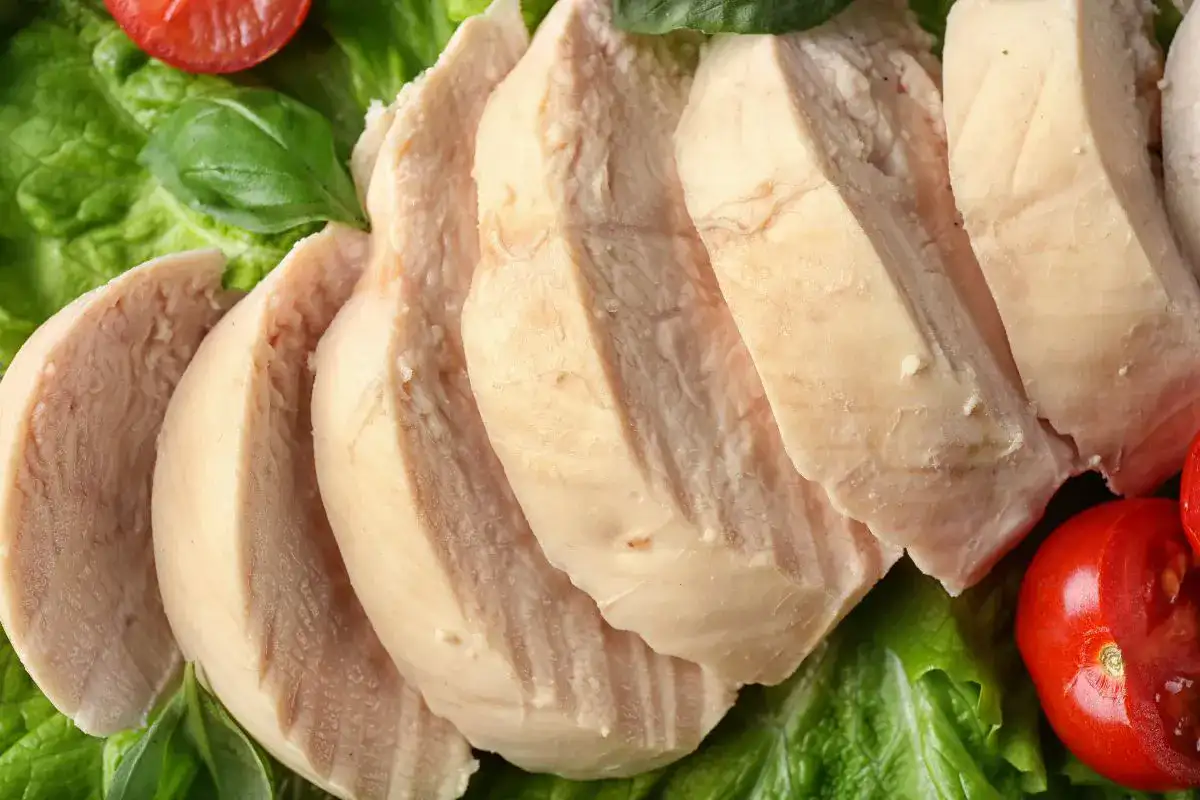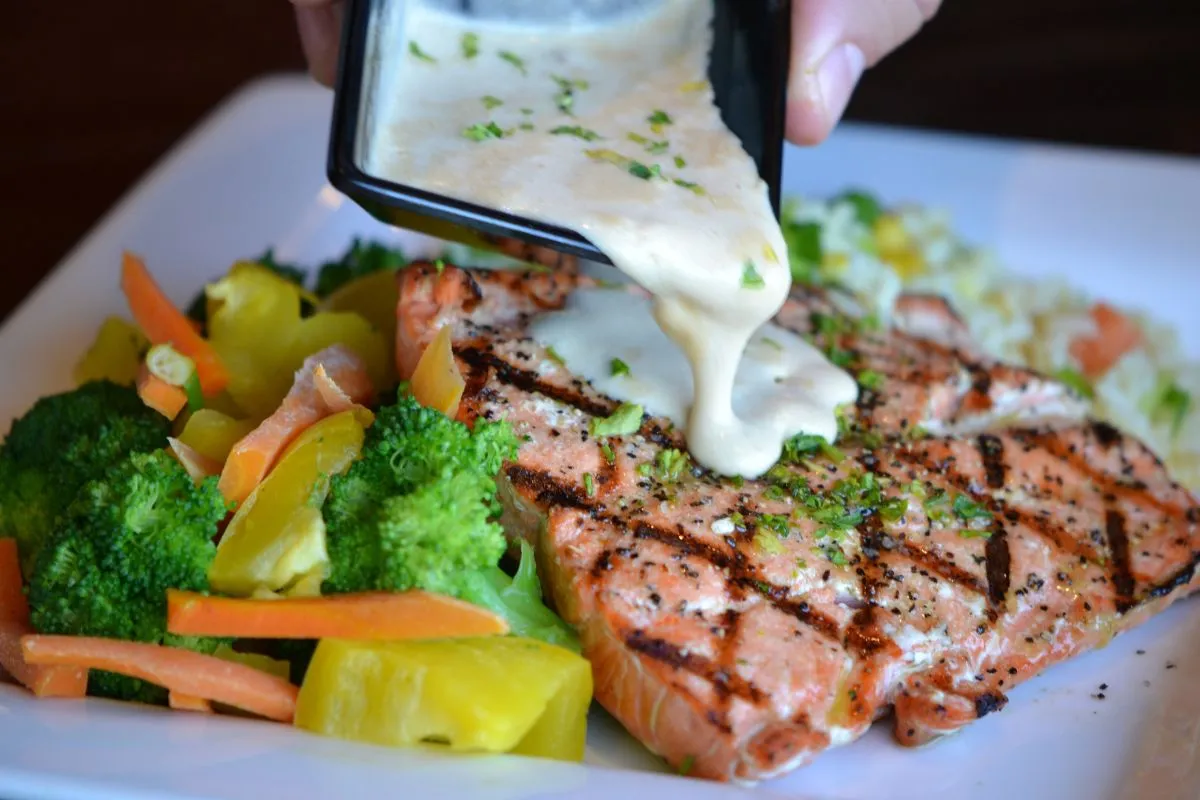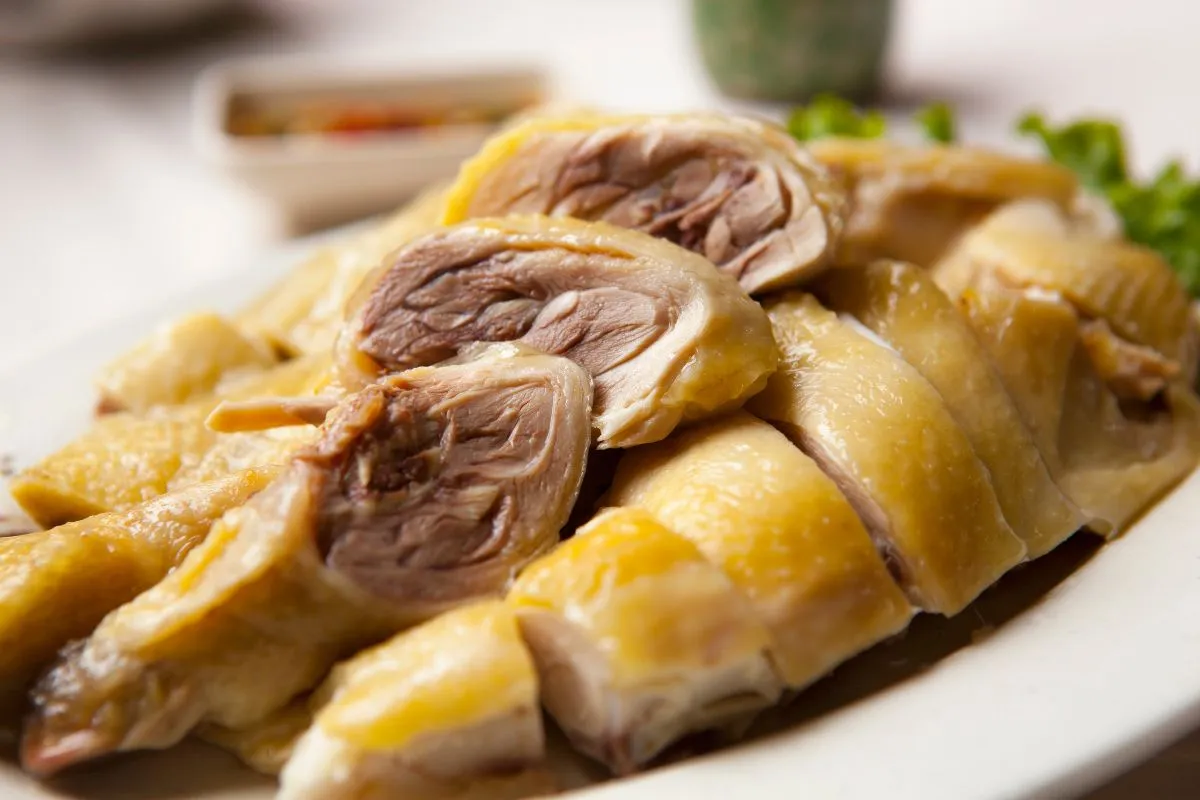Introduction to Boiling Thin-Sliced Chicken Breast
The technique of boiling chicken breast, particularly when thinly sliced, demands careful consideration. This approach is highly valued for those in search of a meal that is swift to prepare, healthy, and flavorful. Thinly slicing the chicken not only accelerates cooking time but also enhances the meat’s ability to soak up flavors, offering a flexible component for a myriad of dishes. This raises an important culinary inquiry: “How long does it take to boil thin sliced chicken breast?”, a question essential for anyone looking to utilize this method for delicious and nutritious meals.
Importance of Cooking Chicken Thoroughly
Cooking chicken thoroughly is paramount for food safety. Chicken must reach an internal temperature of 165°F (74°C) to ensure that harmful bacteria, such as Salmonella and Campylobacter, are killed. This is especially crucial with thin-sliced chicken breast, where the cooking time is reduced, and the risk of uneven cooking is mitigated. The benefits of properly cooked chicken are manifold, including:
- Safety: Eliminates harmful pathogens.
- Texture: Ensures the chicken is tender and not rubbery.
- Flavor: Fully cooked chicken has a better taste profile.
Advantages of Boiling Thin-Sliced Chicken Breast
Boiling thin-sliced chicken breast offers several advantages that make it a preferred cooking method for many. These benefits include:
- Speed: Thin slices cook more quickly, saving time.
- Health: Boiling is a low-fat cooking method, making it healthier.
- Tenderness: Properly boiled chicken is tender and easy to digest.
- Versatility: Easily integrates into various dishes, from salads to soups.
How Long Does It Take to Boil Thin Sliced Chicken Breast?
The question of “How long does it take to boil thin sliced chicken breast?” is central to cooking this dish right. Generally, it takes about:
- 10 to 15 minutes for thin slices to cook thoroughly in boiling water.
However, this duration can vary based on the slice thickness and the initial water temperature. To ensure doneness, check that the chicken’s internal temperature reaches 165°F (74°C).
Tips for Perfect Boiling
Achieving perfectly boiled thin-sliced chicken breast is straightforward with these tips:
- Start with cold water: Begin boiling in cold water for even cooking.
- Season the water: Adding herbs or spices enhances flavor.
- Avoid overcrowding: Cook in batches for even heat distribution.
The Boiling Process Explained
Mastering the art of boiling thin-sliced chicken breast requires a deep understanding of the process, beyond merely submerging the chicken in boiling water. It’s about precise temperature control, accurate timing, and meticulous preparation to ensure the chicken cooks through evenly, remains succulent, and keeps its nutritional value intact. In this exploration, we’ll cover the essential steps and strategies to perfect boiling, addressing the critical question: “How long does it take to boil thin sliced chicken breast?” to guarantee the best outcome.
Preparation Before Boiling
Before diving into the boiling process, proper preparation is crucial. This section outlines the steps needed to get your chicken ready for the pot, ensuring a seamless and efficient cooking experience.
Choosing the Right Chicken Breast
Selecting the right chicken breast is the first step towards a delicious meal. Look for:
- Freshness: Fresh chicken has a pinkish hue and little to no odor.
- Uniformity: Choose breasts that are uniform in size for even cooking.
- Quality: Opt for organic or free-range chicken if possible for better flavor and health benefits.
Preparation and Slicing Tips
Once you’ve selected the right chicken, preparing and slicing it correctly is essential. These tips will guide you through this process:
- Cleaning: Rinse the chicken under cold water and pat dry with paper towels.
- Slicing: To achieve thin slices, use a sharp knife and slice against the grain. This makes the chicken more tender.
- Thickness: Aim for slices about ¼ inch thick for even and quick cooking.
- Batch preparation: If cooking multiple breasts, ensure they are sliced to similar thicknesses to maintain consistent cooking times.
The Boiling Technique
Boiling thin-sliced chicken breast is straightforward, but attention to detail can significantly impact the outcome. Follow these steps for optimal results:
- Fill a pot: Choose a pot large enough to hold the chicken slices without overcrowding. Fill it with enough water to fully submerge the chicken.
- Add flavorings: Enhance the water with salt, herbs, or spices for additional flavor.
- Bring to a boil: Heat the water on high until it reaches a rolling boil.
- Add the chicken: Carefully place the chicken slices into the boiling water. If necessary, adjust the heat to ensure a gentle boil.
- Timing: The crucial question of “How long does it take to boil thin sliced chicken breast?” typically, boiling takes about 10 to 15 minutes. However, the exact time may vary depending on slice thickness and pot size.
- Check doneness: Use a meat thermometer to ensure the chicken reaches an internal temperature of 165°F (74°C). Another method is to check if the meat is no longer pink inside and the juices run clear.
Steps to Boil Thin-Sliced Chicken Breast
Boiling thin-sliced chicken breast is a straightforward yet precise cooking method. It requires attention to detail in terms of water preparation, cooking time, and determining doneness. This section guides you through each step, ensuring your chicken turns out perfectly cooked every time.
Boiling Water Preparation
The first step in boiling chicken is preparing the water. This foundational step sets the stage for the cooking process:
- Pot Selection: Choose a pot large enough to accommodate the chicken without crowding, allowing for even cooking.
- Water Volume: Fill the pot with sufficient water to fully submerge all the chicken slices. Typically, about 1-2 inches of water above the chicken is recommended.
- Flavoring: Consider adding salt, pepper, herbs, or broth to the water to infuse the chicken with extra flavor.
Cooking Time and Temperatures
The core of boiling chicken involves managing the cooking time and temperature. This is crucial for achieving the perfect texture and ensuring food safety:
- Bring to a Boil: Heat the water over high heat until it reaches a rolling boil. This is a vigorous boil that continues even when stirring the water.
- Add the Chicken: Once boiling, gently add the thin-sliced chicken breast to the pot. Reduce the heat to a simmer, where the water is just bubbling gently.
- Cooking Time: The key question, “How long does it take to boil thin sliced chicken breast?” is answered with an approximate time of 10 to 15 minutes. However, adjustments may be necessary based on the chicken’s thickness and the quantity being cooked.
- Monitoring Temperature: Use a cooking thermometer to ensure the chicken reaches an internal temperature of 165°F (74°C), the safe temperature for poultry.
How to Tell When the Chicken is Cooked
Determining when the chicken is fully cooked is the final, critical step. There are a few methods to verify doneness:
- Thermometer Check: The most accurate method is to use a food thermometer. Chicken is safe to eat once it reaches an internal temperature of 165°F (74°C).
- Visual Cues: Look for clear juices and no pink meat inside. The chicken should appear white all the way through.
- Texture Test: Fully cooked chicken should feel firm but not rubbery. If it’s still soft, it may need more time.
Boiling thin-sliced chicken breast is an art that balances time, temperature, and technique. By carefully preparing the water, managing the cooking process, and employing methods to check for doneness, you can ensure perfectly boiled chicken every time. This technique not only guarantees a safe and delicious meal but also retains the nutritional value and tenderness of the chicken, making it a versatile ingredient for numerous dishes.

After Boiling: Tips and Tricks
Once you’ve mastered how to boil thin-sliced chicken breast, the next steps focus on what to do after the chicken is cooked. Properly handling the chicken post-boiling is essential for maintaining its flavor, texture, and nutritional value. Below are key tips and tricks for resting and storing your boiled chicken.
Resting Time
Allowing your chicken to rest after boiling is a critical step that is often overlooked. Resting time serves several important purposes:
- Moisture Retention: Resting allows the juices to redistribute throughout the chicken, ensuring it remains moist and tender.
- Continued Cooking: Even off the heat, the chicken continues to cook slightly from residual heat, reaching the perfect doneness.
- Enhanced Flavor: Giving the chicken time to rest also enhances its flavor, allowing the meat to absorb any herbs or spices used in the boiling water.
To rest the chicken:
- Transfer to a Plate: Use tongs to carefully remove the chicken from the pot and transfer it to a plate or cutting board.
- Cover Loosely: Tent the chicken with foil to keep it warm without trapping too much steam, which can make the surface soggy.
- Resting Duration: Allow the thin-sliced chicken breast to rest for about 5 minutes. This short period is sufficient due to the thinness of the slices.
Storing Leftover Chicken
Proper storage of leftover chicken extends its shelf life and maintains its quality. Follow these guidelines to store your boiled chicken:
- Cooling: Let the chicken cool to room temperature before storing. However, don’t leave it out for more than 2 hours to avoid bacterial growth.
- Refrigeration: Place the cooled chicken in an airtight container or wrap it tightly in plastic wrap or aluminum foil. Store it in the refrigerator.
- Freezing: For longer storage, chicken can be frozen. Wrap it tightly to prevent freezer burn and store it in freezer bags. Label the bags with the date to keep track of how long it’s been stored.
- Shelf Life: In the refrigerator, boiled chicken will last 3-4 days. In the freezer, it can last up to 4 months while retaining its best quality.
When ready to use the stored chicken, ensure it’s reheated to 165°F (74°C) throughout. If thawing frozen chicken, do so in the refrigerator or use the defrost setting on a microwave to prevent bacterial growth.
Mastering the post-boiling steps, including proper resting and storage, is essential for making the most out of your boiled thin-sliced chicken breast. These practices not only ensure food safety but also preserve the texture and flavor of your chicken, making it a delightful addition to your meals throughout the week.
Cooking Variations and Considerations
When boiling thin-sliced chicken breast, the method might seem straightforward, but several variations can significantly affect the outcome. The main SEO keyword, “How long does it take to boil thin-sliced chicken breast?”, emphasizes not just the time but the approach to ensuring the chicken is both safe to eat and delicious.
Seasoning and Flavoring Ideas
Understanding how to properly season and flavor chicken can transform it from a bland protein option into a mouth-watering meal. Here are some simple yet effective techniques:
- Simple seasoning techniques:
- Salt and pepper: Basic yet crucial, the right amount of salt and pepper can greatly enhance the natural flavors of chicken.
- Herb blends: Using combinations like Italian seasoning or Herbes de Provence can introduce a bouquet of flavors suitable for various dishes.
- Marinades for enhanced flavor:
- Citrus and herb: A blend of lemon juice, olive oil, and fresh herbs like rosemary or thyme can impart a refreshing zest.
- Asian-inspired: Soy sauce, ginger, garlic, and honey create a rich, savory, and slightly sweet profile.
Incorporating these seasoning and marinade ideas from DeliciousChef’s Thin-Sliced Chicken Breast Recipes can significantly enhance the flavor of boiled chicken, turning it into a versatile ingredient for a variety of dishes. Also, mastering the art of perfectly cooking thin chicken breasts, as discussed in Mastering Thin Chicken Breast Recipes, is essential for achieving the best results.
By experimenting with these seasoning and marinade techniques, even the simplest boiled chicken can become the star of your culinary creations. Whether you’re looking to keep it light with citrus and herbs or add depth with Asian-inspired flavors, the key is to balance the seasoning to complement the chicken’s natural taste.
Common Mistakes to Avoid
When boiling thin-sliced chicken breast, even seasoned cooks can encounter pitfalls that affect the outcome of their dish. To ensure your chicken is flavorful, tender, and healthy, it’s crucial to steer clear of common mistakes such as overcooking and underseasoning. This section will guide you through these common issues and provide solutions to ensure your chicken comes out perfectly every time.
Overcooking
One of the most frequent errors in preparing thin-sliced chicken breast is overcooking, which can lead to dry, tough meat. To avoid this:
- Monitor Cooking Time: Remember, thin-sliced chicken breast typically takes 10 to 15 minutes to boil. Start checking for doneness around the 10-minute mark.
- Use a Thermometer: The most reliable way to prevent overcooking is to use a meat thermometer. Chicken is done when it reaches an internal temperature of 165°F (74°C).
- Understand the Signs: Familiarize yourself with how cooked chicken looks and feels. It should be opaque and firm to the touch.
Underseasoning
Another common oversight is underseasoning, which can leave your chicken bland and unappetizing. To ensure your chicken is flavorful:
- Season the Water: Adding salt to the boiling water is a basic step, but don’t stop there. Consider aromatic herbs, garlic, or a splash of lemon juice to infuse the chicken with extra flavors.
- Marinate Beforehand: If time allows, marinating the chicken even for a short period before boiling can significantly enhance the taste.
- Adjust Seasonings After Cooking: Taste your chicken after boiling and adjust the seasoning if necessary. A light sprinkle of salt or a dash of fresh herbs can make a big difference.
By avoiding these common mistakes, you can ensure that your thin-sliced chicken breast is not only cooked to perfection but also rich in flavor. Remember, the key to boiling chicken successfully lies in attentiveness to cooking time and temperature, as well as seasoning techniques (as explained in this nutrition article). Keeping these tips in mind will help you achieve delicious results every time you boil chicken, making it a go-to method for quick, healthy, and flavorful meals.
FAQ’s Answered
What’s the safest way to check if the chicken is cooked?
- The safest method to determine if thin-sliced chicken breast is fully cooked is by using a meat thermometer. Insert it into the thickest part of the breast; the chicken is safe to eat when the internal temperature reaches 165°F (74°C).
- Visual cues can also guide you. Cooked chicken should be opaque throughout and the juices should run clear. However, using a thermometer is always more reliable than visual inspection alone.
Can I boil frozen thin-sliced chicken breast?
- Yes, you can boil frozen thin-sliced chicken breast, but it’s important to note that the cooking time may increase by about 50%. Ensure the water covers the chicken by at least an inch and bring it to a boil over medium-high heat.
- Continuously monitor the temperature of the chicken using a meat thermometer to ensure it reaches the safe cooking temperature of 165°F (74°C).
How can I use boiled chicken in recipes?
Boiled thin-sliced chicken breast is incredibly versatile. Here are a few ideas:
- Shred it for chicken salads, tacos, or sandwiches.
- Dice it to add to soups, pasta, or rice dishes.
- Slice it for a healthy protein addition to salads or grain bowls.
- Its mild flavor makes it a perfect canvas for a wide array of seasonings and sauces.
Tips for keeping chicken moist and tender
- Do not overcook: Overcooking is the primary reason for dry chicken. Boil until the internal temperature reaches 165°F (74°C), then remove it from the heat immediately.
- Let it rest: After cooking, let the chicken rest for a few minutes before cutting into it. This allows the juices to redistribute, ensuring the meat remains moist.
- Use a lid: Keeping the pot covered while boiling can help retain moisture in the chicken.
- Brine before cooking: Soaking the chicken in a saltwater solution before boiling can help increase its moisture content, leading to juicier meat.
Conclusion
In summary, understanding the nuances of boiling thin-sliced chicken breast is more than just a question of timing; it’s about perfecting a technique that ensures safety, tenderness, and flavor. From the initial preparation to the final touches of seasoning or marinating, each step offers an opportunity to enhance the natural qualities of the chicken. Embracing simple yet effective seasoning techniques, such as the judicious use of salt and pepper or the aromatic charm of herb blends, can elevate the dish.
Moreover, exploring diverse marinades—from the zest of citrus and herbs to the savory sweetness of Asian-inspired concoctions—can transform boiled chicken from a mere protein option into a culinary centerpiece. As underscored by insights from DeliciousChef, particularly through recipes and cooking tips, the art of boiling chicken is accessible yet profound, inviting cooks to refine their skills and creativity. Thus, whether for health-conscious meals or flavorful feasts, mastering the boil can unlock a world of delightful possibilities.


